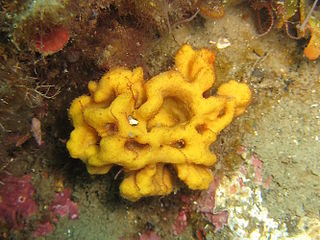Related Research Articles

Halomonadaceae is a family of halophilic Proteobacteria.

In taxonomy, Cenarchaeum is a genus of the Cenarchaeaceae. The marine archaean Cenarchaeum symbiosum lives within the sponge Axinella mexicana.

Axinella is a genus of sponges in the family Axinellidae first described in 1862 by Eduard Oscar Schmidt. Species of Axinella occur in the Indian and Pacific Oceans. Most of these sponges are smaller than 20 cm, and have a yellow or orange colour.
A. marina may refer to:
Dragmacidon lunaecharta, also known as the red ball sponge or red boring sponge, is a species of sea sponge found in the western Atlantic Ocean. It feeds on plankton. These sponges do not attach themselves to rocks or the sea floor but drift in water currents. Its main predators are seaslugs. It has been kept in home aquariums.
Afifella is a genus in the phylum Pseudomonadota (Bacteria). Afifella are found in marine and estuarine settings, including microbial mats. They are anaerobes, with one cultured representative capable of photosynthesis.

Stevensine is a bromopyrrole alkaloid originally isolated from an unidentified Micronesian marine sponge, as well as a New Caledonian sponge, Pseudaxinyssa cantharella and Axinella corrugata. Total synthesis of stevensine has been achieved by Ying-zi Xu et al., and investigations into the biosynthetic origin has been explored by Paul Andrade et al. Understanding methods to synthesize stevensine and other similar compounds is an important step to accomplish, as marine sponges contain numerous biologically active metabolites that have been shown to function as anything from antitumor to antibacterial agents when tested for medicinal applications. Reasons for why marine sponges contain so many bio-active chemicals has been attributed to their sessile nature, and the need to produce chemical defenses to ensure survival. However, since many of these compounds naturally occur in small amounts, harvesting the sponges has in the past led to near-extinction of some species.
Micromonospora echinofusca is an endophytic actinomycete, with type strain DSM 43913T.
Streptomyces haliclonae is a bacterium species from the genus of Streptomyces which has been isolated from the sponge Haliclona sp in the Chiba prefecture from the coast of Tateyama City in Japan.
Streptomyces marinus is a bacterium species from the genus of Streptomyces which has been isolated from the sponge Haliclona sp. from the coastline from the city Tateyama in Japan.
Oceanobacillus is a Gram-positive, rod-shaped and motile bacteria genus from the family of Bacillaceae with a peritrichous flagella. Oceanobacillus species are commonly found in saline environment.
Aureispira marina is a bacterium from the genus of Aureispira which has been isolated from a marine sponge and an algae from the coastline of Thailand.
Thalassotalea is an aerobic and chemo-organo-heterotrophic genus of bacteria from the family Colwelliaceae which occur in the ocean and in sea ice.
Sediminibacillus is a genus of bacteria from the family of Bacillaceae. Sediminibacillus species are halophilic bacteria and found in salty human stools and marine sponges. Sediminibacillus species are identified from Plakortis dariae sponge of the Saint Martin's island of the Bay of Bengal, Bangladesh.
Barrientosiimonas marina is a Gram-positive, non-spore-forming, aerobic and non-motile bacterium from the genus of Barrientosiimonas which has been isolated from seawater from the Mara Island in Korea.
Endozoicomonas is a genus of Gram-negative, aerobic or facultatively anaerobic, chemoorganotrophic, rod-shaped, marine bacteria from the family of Hahellaceae. Endozoicomonas are symbionts of marine animals.
Litorimonas haliclonae is a Gram-negative, rod-shaped and motile bacterium from the genus of Litorimonas which has been isolated from the sponge Haliclona.
Aureitalea is a Gram-negative, obligately aerobic and heterotrophic genus of bacteria from the family of Flavobacteriaceae with one known species, Aureitalea marina. A. marina has been isolated from seawater from the western North Pacific Ocean.
Nonlabens spongiae is a Gram-negative, strictly aerobic, rod-shaped and motile bacterium from the genus of Nonlabens which has been isolated from a marine sponge from the Bahamas.
References
- 1 2 3 4 "Genus: Aureivirga". lpsn.dsmz.de.
- 1 2 Haber, Markus; Shefer, Sigal; Giordano, Assunta; Orlando, Pierangelo; Gambacorta, Agata; Ilan, Micha (1 March 2013). "Aureivirga marina gen. nov., sp. nov., a marine bacterium isolated from the Mediterranean sponge Axinella verrucosa". International Journal of Systematic and Evolutionary Microbiology. 63 (Pt_3): 1089–1095. doi:10.1099/ijs.0.043257-0.